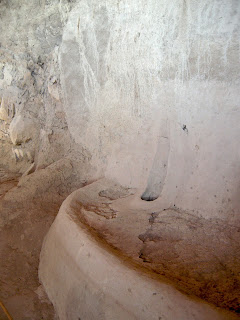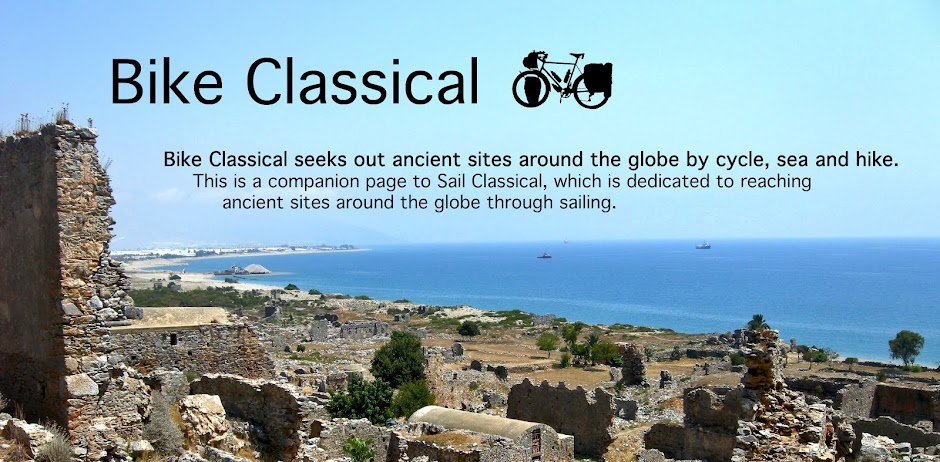Arslantepe: The Palace and Administrative Structure Pt.3
Photos by Jack A. Waldron
*NOTE: I'm sorry for the look of this post, as I accidentally deleted the contents, and had to recover the material from my PATREON . . .

Have I ever mentioned, just how much I love my Disc Trucker?! They are as solid as rocks, ride like passenger transports with a sport suspension, and are priced for the relatively less well off. I know the new 2021 Disc Truckers have undergone some major changes, and there is a lot of chatter both pro and con on social media outlets, but one thing is for sure, a Disc Trucker will get you there on time!!

Pictured above, we are looking over the Elite Residences of the 4th millennium BCE, including the uncovered foreground and to the right of the photo (or, the higher sections of the mound), and if I am not mistaken, the covered area in the immediate left of the photo is actually Temple C, while the Palace Complex with Temples A and B under the covered area further beyond from the same period. The plaguing issue with Arslantepe, as it appears to me, is that so many levels of remains have been built on top of others, that for the lay person, figuring out which layer one is looking at is quite a challenge.

The illustrated mound layout pictured above directly corresponds with the illustration pictured below. When attempting to pinpoint the precise locations of site remains (see the photographs of the site above and below), positioning and identification of buildings becomes a little more challenging.

As I mentioned in a previous post, it is a bit challenging to arrange the illustrations, information, and photos, in an easy to follow order, but I've tried. Pictured below, a section of the uncovered Elite Residences.





The structures covering the excavation create a comfortable labyrinth with signposted stations that require an in depth explanation of what is where, and why. Pictured above, this photo is looking over the lower Palace Complex, with the Elite Residences higher up in the distance, which is reflected in the site illustration pictured below.



Exploration of the site begins by entering the Monumental Gate, that today with its low walls, is a bit less monumental (pictured below).

The Palace Complex area of the site has been excavated down to the 4th millennium BC, which are pictured here.

We are starting at the bottom of the slope (#3 in the illustration below) and climbing up toward the Elite Residences.


Pictured below, a post hole sits empty, where once a wooden pole or post would have risen to support an upper structure of some sort.

Continuing on through the labyrinth of the low walls and hidden rooms that visitors are not allowed to enter makes it very challenging to photograph the signifying markers of each space.

The protective roof, or to be more accurate, roofs, of the Palace Complex are temporary, and as the excavations allow for a more permanent cover, one hopes that a single massive structure similar to those at Catalhoyuk will be built over the site.

Moving on to the Palace Temples, there are fascinating diamond shaped reliefs carved into the walls, as well as wall paintings, which you can see in my photos further down.

We will explore these symbolic reliefs (pictured below) and wall paintings more deeply as we go.




It is nearly impossible to see the illustration superimposed over these photos, but trust me, the temples are there.

Pictured above and below, the low mud brick walls of Temple A enclose a central hearth, as well as storerooms for food and goods.

Temple B is much easier to discern in my photos below, as the space is larger and easier to view.








As you can see, Temple be follows a similar functional layout to Temple A, though larger and much easier to recognize.

At Arslantepe, there is also Temple C (see photo at the top of the post), that unfortunately I was not allowed to access. Actually, the whole of the acropolis was closed, and the only reason I was allowed to walk the single path around it was because I explained that I was writing a blog about the site. I did have to stick to the path, and when I had completed the tour of the acropolis, there was a phone call from Italy to the guards at the site to inform them that the satellites had seen some people walking around the restricted area.

As I understand the development and function of Temple C, this structure was among the first to be dedicated to a newly organized system that would develop into what is known as 'state'. Temple C was larger than the later built Temples B and A, and was much more accessible to the public, not being more religiously restrictive as the later mentioned.

Stores of cereals and other food stuffs collected as religious donations or taxes would be distributed to the public for numerous purposes, such as payment for services, religious ceremony, to those in need, etc. This centralized power of distribution grew, and from it the advent of the 'elite' class dawned, who took on a greater and greater role as the organizers of the 'state' and its functioning bodies.




As modern governments have taken over the management and distribution of community funds (aka taxes), and have outgrown the reach and might of religious power, so was the case during 4th millennium Arslantepe. The palace temples were smaller in size and scope when compared to the function of the earlier purposed Temple C. In its stead, and with regard to the welfare of the populace, the elites filled the previous economic and management roles of the temple, by placing it under 'state' functions.

Palace Temples A and B were no longer accessible to the populace, which would have made accountability of its stores nearly impossible monitor. Here, we may be able to describe a transfer of power from the the temple to the state. However, the outside walls of the temples were decorated with religious paintings and reliefs, perhaps in an effort to reinforce the older traditions and temple functions (see below).


In the photo above, you can see the religious "lozenge-shaped impressions" that were set in the wet plaster of the temple walls and surfaces. The meaning and purposes behind these symbols are open for discussion.

Pictured below, an opposing view of the central store room of the lower palatial complex, and more importantly, the original paintings dated to between 3350-3000 BCE.

These rooms served various functions with regard to the storage of processed foods and cereals, with each being dedicated to its specific use, and further, access would be controlled through the use of seals.

As you can see in these photos, the sun is reaching an angle at which its damaging rays will hit the paintings, and as I was quickly snapping these pictures the site security was standing at the ready to close the curtain on any further viewing of the priceless works of art.

These paintings could be found at palace passageways throughout the complex, and were meant to reinforce the powers and religious prominence of the gods represented.

In both the painting above and below, it would appear that a standing figure in human form, probably wearing a shaman's mask, is raising their arms in front of an altar, and performing a religious ceremony. Further, in the photo above, there appear to be trees and other greenery in a natural setting, perhaps representative of fruit bearing plants.

As you can see in the closeup below, these figures do appear to be male, and thus display the dominance of patriarchy within the religious and social order.

Pictured below, reproductions of the paintings on display at the Malatya Archeological Museum.




The 'palace period' (3350-3000 BCE) was a time centralized social structure marked by a focus on community support and benefit of production.

Pottery during this period was diverse in both type and production, being made of hand formed and wheel-spun types.






The storerooms pictured below would have been filled with various shapes and sizes of pottery (such as those pictured above), with the rooms sealed with clay door security, which displayed an image to signify certain information.

I will allow the Malatya Archeological Museum take over the explanation of the storeroom security system used at Arslantepe during the 4th and early 3rd millennium BCE for the remainder of this post. I think what you'll find is that nothing has really changed over the past 4 thousand years, only the methods and materials employed to do the same jobs.










Explanations of the depictions on some of these seals below can be found in the information provided above.











*All photos and content property of Jack A. Waldron (photos may not be used without written permission)
